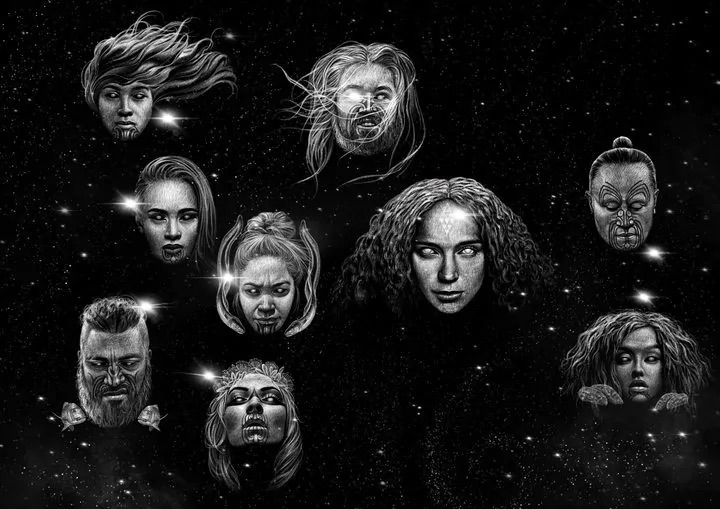Te Iwa O Matariki

Te Iwa O Matariki | The Nine Stars Of Matariki

Matariki
Māori use the name Matariki to describe the entire cluster of Pleiades. The different names of the whetu (stars) in the Matariki group are significant to Māori, as each individual has a defined purpose and is intrinsically connected with the Māori world. Source: Matariki The Star of the Year by Dr Rangi Matamua.
1. Matariki – the mother of the eight whetu in the constellation.
The whetu Matariki was taken as a wife by Rehua (not considered part of the Matariki constellation – he is the great lord of the stars, the whetu Antares, which Māori believe is paramount chief of the heavens). Matariki is connected to wellbeing, and at times Matariki was viewed as an omen of good fortune and health. If the cluster, and especially the individual Matariki whetu was seen high and bright in the night sky, it denoted good luck, peace and wellbeing for those who observed it. If it was seen in the sky when a patient was suffering from an illness it was taken as a sign they would soon recover. This association with health is affirmed in the saying ‘Matariki, huarahi ki te oranga tangata’; ‘Matariki, pathway to the wellbeing of man’. It is important to note that Rehua is also connected to wellbeing and medicine and those suffering from ailments would trust in Rehua for the power to heal. It is within both Rehua and Matariki that knowledge of wellbeing and medicine exists, and both have the power to heal. Together Rehua and Matariki produced the other whetu in the cluster, each with its own unique purpose and meaning.
2. Pōhutukawa – is connected to the dead, and in particular those who have passed on from the world since the last heliacal rising of Matariki in the month of Pipiri.
Māori belief determines that when an individual dies, their spirit leaves their body and undertakes a journey along Te Ara Wairua, the pathway of the spirits. This journey ends at the northernmost point of the North Island at a place called Te Rerenga Wairua (the departing place of the spirits). The dead travel along the rocky ledge towards the ocean where an ancient pōhutakawa tree stands. They then descend the aka (root) of this tree and disappear into the underworld. ‘Below Te Aka, the long dry root of the pōhutakawa which does not quite reach the sea, is Maurianuku, the entrance to the underworld. Pōhutakawa is the whetu that connects Matariki to the deceased and it is the reason why people would cry out the names of the dead and weep when Matariki was seen rising in the early morning.
3. Tupuānuku – is the whetu associated with food grown in the ground.
This whetu is connected to all cultivated and uncultivated food products and is the reason the Matariki cluster is immortalised in the proverb ‘Hauhake tū, ka tō Matariki’; ‘Lifting of the crops begins when Matariki sets’. When Matariki sets in the western sky at dusk during the month of May, the harvesting of the gardens has been completed and winter is near.
4. Tupuārangi – is associated with food that comes from the sky. Tupuārangi is linked to birds.
During the rising of Matariki, kererū were harvested in large numbers, cooked and then preserved in their own fat. This activity gave rise to the statement ‘ka kitea a Matariki, kua maoka te hinu,’ meaning ‘When Matariki is seen the fat of the kererū is rendered so the birds can be preserved’. Tupuārangi connects the cluster to the harvesting of birds and other elevated food such as fruit and berries from the trees.
5. Waitī –is connected to fresh water and all of the creatures that live within rivers, streams and lakes.
The association Waitī and Matariki have with the creatures of fresh water is reflected in the proverb ‘Ka kitea a Matariki ka rere te korokoro’. The korokoro is the lamprey, and these aquatic creatures leave the ocean during late winter and early spring, migrating up freshwater streams to spawn. This process occurs when Waitī is seen in the morning sky.
6. Waitā – is associated with the ocean, representing the many kinds of food Māori gather from the sea.
Furthermore it is said that when Matariki sits just above the water horizon, it has significant influence over tides of the ocean and the floodwaters.
7. Waipunarangi – is connected to the rain, and the name itself can be translated to mean ‘water that pools in the sky’.
The pooling of water on the ground caused by heavy and persistent showers of the winter months are referred to as Matariki tāpuapua’.
8. Ururangi – means ‘the winds of the sky’.
This whetu determines the nature of the winds for the year.
9. Hiwa-i-te-rangi – is the final whetu in this group and its name is connected to the promise of a prosperous season.
It is to Hiwa that Māori would send their dreams and desires for the year in the hope that they would be realised. This tradition is similar to the notion of wishing upon a whetu, or a New Year’s resolution.
